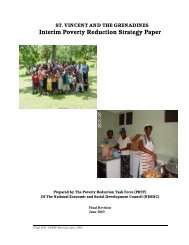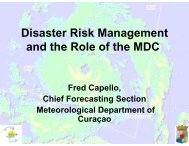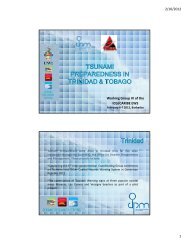The Anatomy of A Silent Crisis The Anatomy of A Silent Crisis
The Anatomy of A Silent Crisis The Anatomy of A Silent Crisis
The Anatomy of A Silent Crisis The Anatomy of A Silent Crisis
- TAGS
- anatomy
- www.bb.undp.org
You also want an ePaper? Increase the reach of your titles
YUMPU automatically turns print PDFs into web optimized ePapers that Google loves.
End notes<br />
107<br />
Somaliland, 41. Sri Lanka, 42. Sudan, 43. Syria, 44.<br />
Uganda, 45. Uzbekistan, 46. Zimbabwe<br />
172. Conflicts over control <strong>of</strong> scarce resources such<br />
as fertile land and water are included in this<br />
figure along with conflicts over natural resources<br />
including timber, minerals and oil. UNEP. (2009):<br />
“From conflict to peacebuilding.” United Nations<br />
Environmental Programme. http://postconflict.unep.<br />
ch/publications/pcdmb_policy_01.pdf.<br />
173. UNEP. (2009): “From conflict to peacebuilding.” United<br />
Nations Environmental Programme. http://postconflict.<br />
unep.ch/publications/pcdmb_policy_01.pdf.<br />
174. CDC. (2009): “Notice to Readers: World Water Day.”<br />
US Centers for Disease Control and Prevention, March<br />
22. http://www.cdc.gov/mmwr/preview/mmwrhtml/<br />
mm5810a5.htm.<br />
175. Buhaug, H., Gleditsch, N., and <strong>The</strong>isen, O. (2008):<br />
“Implications <strong>of</strong> Climate Change for Armed Conflict.” <strong>The</strong><br />
World Bank Group, Social Development Department.<br />
176. UNDP. (2006): “Spectre <strong>of</strong> ‘water wars’ distracts from<br />
urgent need for cross-border cooperation.” United<br />
Nations Development Programme.<br />
177. Haag, A.L. (2005): “Checking earth’s vital signs.”<br />
NASA Earth System Science Data and Services,<br />
October 12. http://nasadaacs.eos.nasa.gov/<br />
articles/2005/2005_mea.html.<br />
178. In 1951 a violent feud erupted between the Amhaz<br />
and the Tawk, leading Muslim and Christian families in<br />
the area over water diversion.<br />
179. IRIN. (2009): “Lebanon: Climate change and politics<br />
threaten water wars in Bekaa.” Integrated Regional<br />
Information Networks, April 1. http://www.irinnews.<br />
org/Report.aspx?ReportId=82682.<br />
180. According to Randa Massad, an irrigation expert at<br />
the Lebanese Agricultural Research Institute.<br />
181. <strong>The</strong> Himalayan glaciers are the largest body <strong>of</strong> ice<br />
outside the Polar ice caps, occupying approximately<br />
500,000 square kilometres.<br />
182. Cruz, R.V., et al. (2007): “Asia.” Climate Change 2007:<br />
Impacts, Adaptations and Vulnerability, Contribution<br />
<strong>of</strong> Working Group II to the Fourth Assessment Report<br />
<strong>of</strong> the Intergovernmental Panel on Climate Change,<br />
M.L. Parry, et al. Eds., Cambridge University Press,<br />
Cambridge, UK,469-506, p493.<br />
183. Ellis, L. (2008): “Climate Change, Water, and the<br />
Himalayas.” Woodrow Wilson International Center<br />
for Scholars. http://www.wilsoncenter.org/index.<br />
cfm?topic_id=1421&fuseaction=topics.event_<br />
summary&event_id=479527.<br />
184. Schild, A. (2008): “ICIMOD’s Position on Climate<br />
Change and Mountain Systems: <strong>The</strong> Case <strong>of</strong> the<br />
Hindu Kush-Himalayas.” International Centre for<br />
Integrated Mountain Development.<br />
185. Maplecr<strong>of</strong>t’s Climate Change Vulnerability Indicator<br />
(CCVI): Quantification at sub-national level.<br />
‘Vulnerability’ is defined as a combination <strong>of</strong> factors<br />
that influence the capacity <strong>of</strong> individuals, communities,<br />
economies and societies to reduce the risks from<br />
changes in patterns <strong>of</strong> natural hazards and impacts<br />
on ecosystem services as a result <strong>of</strong> climate change.<br />
<strong>The</strong> CCVI constitutes <strong>of</strong> six factors: economy; natural<br />
resources and ecosystems; poverty, development<br />
and health; agriculture; population, settlement and<br />
infrastructure; and institutions, governance and social<br />
capital. A sub-index was developed for each group<br />
and these were combined to form the CCVI. <strong>The</strong><br />
natural resources and ecosystems and agriculture<br />
sub-indices are weighted twice as heavily as the<br />
others. <strong>The</strong> index values range from 0 to 10, where 0<br />
equals highest risk and 10 equals lowest risk. For the<br />
purposes <strong>of</strong> this analysis, we have defined ‘vulnerable’<br />
countries as those with a mean CCVI <strong>of</strong> 5 or less and<br />
‘extremely vulnerable’ countries as those with a mean<br />
CCVI <strong>of</strong> 2.5 or less.<br />
186. Friedman, T.L. (2008): Hot, Flat and Crowded -Why<br />
We Need a Green Revolution - And How it Can Renew<br />
America. Farrar, Straus & Giroux, p.158.<br />
187. McCarthy, M. (2008): “Why Canada is the best<br />
haven from climate change.” UK Independent. July 4.<br />
http://www.independent.co.uk/environment/climatechange/why-canada-is-the-best-haven-from-climatechange-860001.html.







